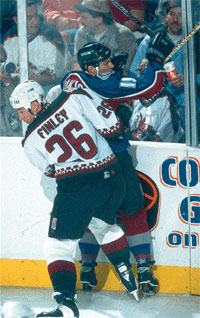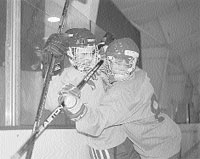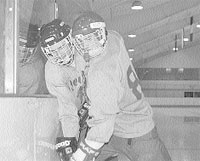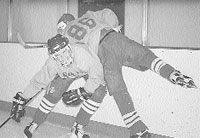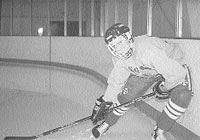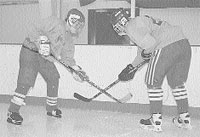| HockeyPlayer.com Playing
There are two basic ways to check another player: legally or illegally. (Checking is further broken down into two techniques, body checking and stick checking, which will be discussed). Legal checks will not result in a penalty whereas the illegal ones will. In fact, when trying to understand how to check an opposing player, the playing rules, in so far as they tell players what not to do, are helpful in understanding checking. For example, every league prohibits checking another player from behind, checking with a high stick, charging, boarding, cross-checking, butt-ending, roughing, interference, hooking, elbowing, and kneeing. Each of these penalties addresses the use of an illegal check where a player either hits another player from the wrong angle (hitting from behind); at the wrong time (interference); with the stick instead of the body (high sticking, cross-checking, butt-ending, and hooking); with the use of a body part which can cause injury (elbowing and kneeing); or, if the check is delivered with excessive force (roughing and boarding). Thus, the first lesson in checking is to understand what your league permits. However, one universal caveat should be understood by all players: Never hit another player from behind, especially when that player is facing the boards and the player is in the �red zone,� which is an imaginary line going around the entire circumference of the rink five feet from the boards toward center ice. The second lesson to checking is to understand all the various techniques since each is designed for use in a particular situation.
Body checking The first checking technique is the body check. There are essentially two forms of the body check; the classic body check (sometimes called the shoulder check or the front check), and the hip check. With the body check, the purpose is simple. You want to separate an opposing player from the puck while maintaining your balance and position without committing a penalty. Essentially, you are checking another player with the front of your body while facing the front of the other player�s body. In performing the check, you want to use the entire body to check the opposing player, although your shoulder will be the main thrust and support in delivering the check. After the check has been completed, you want to be in a position to either gain possession of the puck or switch to an offensive mode assuming your team has gained possession of the puck. In terms of when to use the body check, this is probably the most often used check in hockey (aside from stick checking). It is recommended for all players (although most leagues for players 10 years old and under prohibit any checking) at any place on the ice. In terms of technique, all players should understand the following points: Approach the opposing player in a balanced position. Often players will approach another player and either jump or turn to one side when they make contact with the other player. Although NHL players may check in this manner, younger players should avoid it for several reasons. First leaving your feet is a penalty (charging). Second, if you do not make contact squarely with the other player, you take away the force of your check. Finally, by not maintaining your balance, although you may strip the opposing player of the puck, you may also take yourself out of the play. By maintaining your balance you also may fight for possession of the puck after delivery of the check. Avoid contacting the player so as to cause a penalty. Avoid holding your stick off the ice (i.e., in a cross-check position). If your stick is off the ice, this means that not only can the other player not play the puck after the check has been delivered, but neither can you. Additionally, your stick, if used properly, can be used as wedge to tie the other player up if the puck is knocked loose and there is a scramble for the puck. If your stick is off the ice (either waist high or even worse, shoulder high), you give away a checking advantage. Always keep your head up and your eyes on the opponent, not the puck! Photo 1 illustrates the improper way in which to deliver a body check. In this picture, the player delivering the check has his stick up which may lead to a penalty. Additionally, he is off balance. Finally, one of the checking player�s gloves is in the face of the puck carrier. Again, this may be a penalty. This check will probably draw some sort of call and the player delivering the check is in no position to play the puck. In Photo 2, the checker delivers a proper body check. The checker is now using his shoulders, a great source of strength. Further, this technique will not cause injury nor draw a penalty. Finally, the balanced and controlled posture of the checker allows him to deliver the check and then either tie up the puck carrier or play the puck himself.
The hip check Like the body check, the hip check can bring the crowd to its feet. On the negative, however, it is not an easy maneuver to execute since it requires timing and balance. The hip check is best delivered along the boards where the puck carrier has little room for escape. The checker must be back skating and approaching the puck carrier from the side. The checker will execute a �pinch off� against the boards while delivering a blow with the hip into the corresponding hip of the puck carrier. Timing is important since the hip check is swung only at the last second. It is delivered by curling the body with good knee and hip flexion. In effect, the checker �crouches� and swings into the carrier. The knee nearest the puck carrier remains bent while the knee away from the puck carrier will straighten with a sudden thrust of the leg. Photo 3 best illustrates this technique.
The hip check form can actually be practiced by crouching and leaning into a wall. Get the feel of driving off the leg away from the carrier. The player�s goal should be to pinch off the puck carrier and not to necessarily toss him or her over your back although the puck carrier�s momentum may allow for that. Photo 4 illustrates this concept.
Stick checks While the body checks are certainly more dramatic, stick checks are more often used and can be more effective in the overall sense of team defense. There are various techniques for stick checking. For example, there is the poke check, lift check, press check, sweep check, and the �legal� hook check.
The poke check The poke check coming from a back-skating defenseman is a commonly used stick check. The defender must keep the top of the stick close to the hip ready to thrust the blade out at the puck. Do not tip off your range here; keep the stick tight to the body. Also, it is a good technique to keep the palm of the hand which holds the stick in a face down position. This means that the stick blade will also be face-down and �closed.� There is less tendency to sweep the stick and more of a poking technique will be employed. Since the stick is held only by the top hand and is directly in front of the back-skating defender, one must avoid the sweeping motion often seen by young, inexperienced defensemen. Also avoid the tendency to thrust with a leg or upper body since this over-commits you to the carrier and you cannot recover when deked. Remember two key rules: 1) Keep skating backward. 2) Always play the body after poking the puck away (for defensemen, this is commonly called �stepping-up�). Poke checking for forwards often means that they are approaching the puck carrier from the side so more of a sweeping motion may be prudent. It also may mean that you endeavor to strike the carrier�s stick, about midway down the shaft, in an attempt to slap the puck away. Be sure to use only one hand on your stick since a slap with two hands will almost always be called a slash. Diving to knock away a puck with a one-handed poke check will almost always draw a penalty especially if the carrier trips over the checker (who has left his or her feet).
Lift check The lift check is a surprise move and the technique is simple: Tap the opposing player�s stick up from the ice and quickly return your stick back to the ice to gain possession of the puck. In other words, when two players are going after a loose puck the player who arrives slightly later can be at an advantage if he or she suddenly lifts up the stick of the other player and scoops the puck away. Photo 5 illustrates the lift check. Notice the player on the left is lifting the other player�s stick. Another tip is to lift the player�s stick near the blade because this will make it harder for the other player to resist.
Press check The opposite of the lift check is the press check. In executing the press check, the checker endeavors to keep the other player from using his or her stick to receive a pass or get a shot away. This is often used in front of the defensive net. We insist, as coaches, that our defensemen always maintain some sort of physical contact with attackers in front of the cage. A defender�s stick on an attacker�s stick or a stick on their leg pads or waist should be maintained so that you know where the attacker is all times. In this way, you can anticipate the player�s movements and employ a hard downward pressing action on the other player� s stick to inhibit their offensive capabilities.
The legal hook check This check is employed when the checker approaches the puck carrier from behind (and usually at center ice). The technique is not to hook, but to tug on the puck carrier�s hips (first one side and then the other) to slow the carrier down. Players executing this check make two common mistakes: First, never stop skating; because if you do you will either incur a penalty (i.e., hooking) or the puck carrier will simply pass you by. Second, it is important that you alternate sides when you tug on the puck carrier to avoid hooking the player. Also, avoid slashing, hacking, or spearing the puck carrier. Another excellent technique is to �pick� at the top hand of the carrier since it is often a control hand and the carrier may lose possession as the puck trickles away. You may also be able to deceive the carrier by tapping his or her hip on one side and driving across the other side with a lift check. Neither technique may be effective against good hard skaters, but at the very least you might distract them or force them into a move or skating line they would not prefer. If you are wary enough to force the carrier to his or her backhand side, you might effectively limit the carrier�s shot.
Sweep check This is the most popular fore-checking technique used by most forwards. Essentially, you approach the puck carrier from center ice heading toward the boards. The idea is to force the player outside. At the same time you �chase� the puck carrier, the top hand is on the stick and the stick is �swept� across the ice in a sweeping motion (side to side) in an effort to knock the puck free from the puck carrier�s stick. The key to executing this check is as follows: First, unless you are a forward defending against a point man in your defensive zone, never approach the puck carrier head on. Always angle (by using forwards and backwards crossovers) the puck carrier while sweeping your stick. Second, some coaches advocate staying low and swinging the stick to and fro in an effort to distract and/or upset the timing of the puck carrier�s potential outlet pass. Whatever the technique used, the fore-checker must always keep eye to eye contact with the puck carrier since the carrier will often tip off where they intend to pass the puck by looking in one direction or the other. Checking can be exciting, but often it goes unnoticed. However, any coach will tell you that effective checking is the key to creating opportunities to gain possession of the puck�which leads to scoring goals. Never overlook the importance of a good, legal check. This first appeared in the 01/1997 issue of Hockey
Player Magazine® |
|
|
home
| about us |
sample articles
shop | free
trial | member login
Last Updated: Sep 13th, 2007 - 20:41:00

